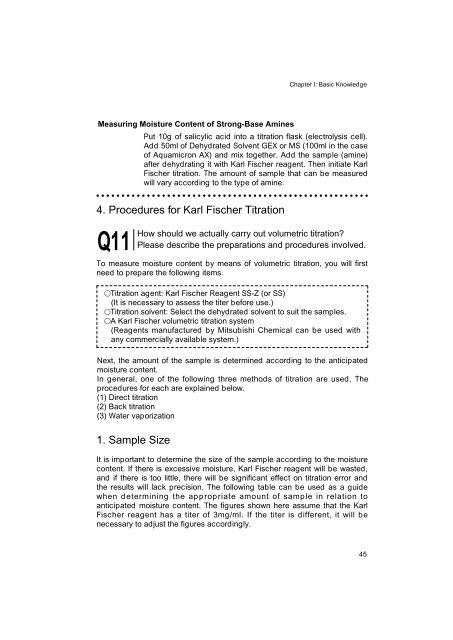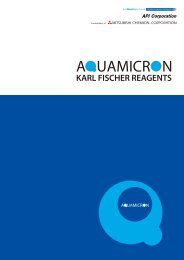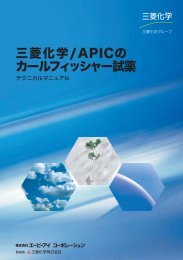Development of Karl Fischer Reagents
Development of Karl Fischer Reagents
Development of Karl Fischer Reagents
You also want an ePaper? Increase the reach of your titles
YUMPU automatically turns print PDFs into web optimized ePapers that Google loves.
Chapter I: Basic Knowledge<br />
Measuring Moisture Content <strong>of</strong> Strong-Base Amines<br />
Put 10g <strong>of</strong> salicylic acid into a titration flask (electrolysis cell).<br />
Add 50ml <strong>of</strong> Dehydrated Solvent GEX or MS (100ml in the case<br />
<strong>of</strong> Aquamicron AX) and mix together. Add the sample (amine)<br />
after dehydrating it with <strong>Karl</strong> <strong>Fischer</strong> reagent. Then initiate <strong>Karl</strong><br />
<strong>Fischer</strong> titration. The amount <strong>of</strong> sample that can be measured<br />
will vary according to the type <strong>of</strong> amine.<br />
4. Procedures for <strong>Karl</strong> <strong>Fischer</strong> Titration<br />
Q11<br />
How should we actually carry out volumetric titration?<br />
Please describe the preparations and procedures involved.<br />
To measure moisture content by means <strong>of</strong> volumetric titration, you will first<br />
need to prepare the following items.<br />
�Titration agent: <strong>Karl</strong> <strong>Fischer</strong> Reagent SS-Z (or SS)<br />
(It is necessary to assess the titer before use.)<br />
�Titration solvent: Select the dehydrated solvent to suit the samples.<br />
�A <strong>Karl</strong> <strong>Fischer</strong> volumetric titration system<br />
(<strong>Reagents</strong> manufactured by Mitsubishi Chemical can be used with<br />
any commercially available system.)<br />
Next, the amount <strong>of</strong> the sample is determined according to the anticipated<br />
moisture content.<br />
In general, one <strong>of</strong> the following three methods <strong>of</strong> titration are used. The<br />
procedures for each are explained below.<br />
(1) Direct titration<br />
(2) Back titration<br />
(3) Water vaporization<br />
1. Sample Size<br />
It is important to determine the size <strong>of</strong> the sample according to the moisture<br />
content. If there is excessive moisture, <strong>Karl</strong> <strong>Fischer</strong> reagent will be wasted,<br />
and if there is too little, there will be significant effect on titration error and<br />
the results will lack precision. The following table can be used as a guide<br />
when determining the appropriate amount <strong>of</strong> sample in relation to<br />
anticipated moisture content. The figures shown here assume that the <strong>Karl</strong><br />
<strong>Fischer</strong> reagent has a titer <strong>of</strong> 3mg/ml. If the titer is different, it will be<br />
necessary to adjust the figures accordingly.<br />
45




